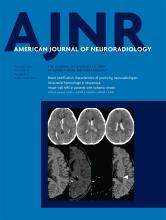Index by author
Hagiwara, A.
- Adult BrainOpen AccessWhite Matter Abnormalities in Multiple Sclerosis Evaluated by Quantitative Synthetic MRI, Diffusion Tensor Imaging, and Neurite Orientation Dispersion and Density ImagingA. Hagiwara, K. Kamagata, K. Shimoji, K. Yokoyama, C. Andica, M. Hori, S. Fujita, T. Maekawa, R. Irie, T. Akashi, A. Wada, M. Suzuki, O. Abe, N. Hattori and S. AokiAmerican Journal of Neuroradiology October 2019, 40 (10) 1642-1648; DOI: https://doi.org/10.3174/ajnr.A6209
Hakim, A.
- LetterYou have accessAn Important Pitfall in Diagnosing Intracanalicular Vestibular SchwannomaA. Hakim and F. WagnerAmerican Journal of Neuroradiology October 2019, 40 (10) E58-E59; DOI: https://doi.org/10.3174/ajnr.A6192
Halasy, M.P.
- FELLOWS' JOURNAL CLUBSpine Imaging and Spine Image-Guided InterventionsYou have accessComparison of [18F] FDG-PET/MRI and Clinical Findings for Assessment of Suspected Lumbar Facet Joint Pain: A Prospective Study to Characterize Candidate Nonanatomic Imaging Biomarkers and Potential Impact on ManagementV.T. Lehman, F.E. Diehn, S.M. Broski, M.A. Nathan, B.J. Kemp, N.B. Larson, R.A. Shelerud, J.S. Brault, M.P. Halasy and T.P. MausAmerican Journal of Neuroradiology October 2019, 40 (10) 1779-1785; DOI: https://doi.org/10.3174/ajnr.A6224
Ten patients with clinically suspected facetogenic low back pain were prospectively recruited with a designation of specific facet joints implicated clinically. Subsequently, patients underwent an FDG-PET/MR imaging examination with gadolinium. Each facet joint was graded for perifacet signal change on MR imaging and FDG activity. The frequency and correlation of MR imaging, FDG-PET, and clinical findings were determined. There was low concordance of perifacet signal change and FDG activity with clinically implicated facet joints. This could indicate either the potential to change patient management or a lack of biomarker accuracy.
Han, X.-W.
- NeurointerventionOpen AccessApplication of High-Resolution C-Arm CT Combined with Streak Metal Artifact Removal Technology for the Stent-Assisted Embolization of Intracranial AneurysmsT.-F. Li, J. Ma, X.-W. Han, P.-J. Fu, R.-N. Niu, W.-Z. Luo and J.-Z. RenAmerican Journal of Neuroradiology October 2019, 40 (10) 1752-1758; DOI: https://doi.org/10.3174/ajnr.A6190
Hansen, B.
- Adult BrainYou have accessAn Introduction to Kurtosis Fractional AnisotropyB. HansenAmerican Journal of Neuroradiology October 2019, 40 (10) 1638-1641; DOI: https://doi.org/10.3174/ajnr.A6235
Hattori, N.
- Adult BrainOpen AccessWhite Matter Abnormalities in Multiple Sclerosis Evaluated by Quantitative Synthetic MRI, Diffusion Tensor Imaging, and Neurite Orientation Dispersion and Density ImagingA. Hagiwara, K. Kamagata, K. Shimoji, K. Yokoyama, C. Andica, M. Hori, S. Fujita, T. Maekawa, R. Irie, T. Akashi, A. Wada, M. Suzuki, O. Abe, N. Hattori and S. AokiAmerican Journal of Neuroradiology October 2019, 40 (10) 1642-1648; DOI: https://doi.org/10.3174/ajnr.A6209
He, Y.
- EDITOR'S CHOICENeurointerventionOpen AccessSafety and Efficacy of Transvenous Embolization of Ruptured Brain Arteriovenous Malformations as a Last Resort: A Prospective Single-Arm StudyY. He, Y. Ding, W. Bai, T. Li, F.K. Hui, W.-J. Jiang and J. XueAmerican Journal of Neuroradiology October 2019, 40 (10) 1744-1751; DOI: https://doi.org/10.3174/ajnr.A6197
Twenty-one consecutive patients with ruptured brain AVMs who underwent transvenous embolization were prospectively followed between November 2016 and November 2018. Complete AVM nidus obliteration was shown in 16 (84%) of 19 patients. One (5%) patient with a small residual nidus after treatment showed complete obliteration at 13-month follow-up. There were 5 hemorrhages and 1 infarction; 4 patients' symptoms improved gradually. Transvenous embolization can be performed only in highly selected hemorrhagic brain AVMs with high complete obliteration rates, but it should not be considered as a first-line treatment.
Herzberg, M.
- NeurointerventionYou have accessLow-Profile Intra-Aneurysmal Flow Disruptor WEB 17 versus WEB Predecessor Systems for Treatment of Small Intracranial Aneurysms: Comparative Analysis of Procedural Safety and FeasibilityL. Goertz, T. Liebig, E. Siebert, M. Herzberg, L. Pennig, M. Schlamann, J. Borggrefe, B. Krischek, F. Dorn and C. KabbaschAmerican Journal of Neuroradiology October 2019, 40 (10) 1766-1772; DOI: https://doi.org/10.3174/ajnr.A6183
Hirsch, J.A.
- EDITOR'S CHOICEYou have accessBoard Certification Characteristics of Practicing NeuroradiologistsA.B. Rosenkrantz, G.N. Nicola, J.A. Hirsch and R. DuszakAmerican Journal of Neuroradiology October 2019, 40 (10) 1610-1616; DOI: https://doi.org/10.3174/ajnr.A6225
Of 3769 included radiologists ever subspecialty certified, 84.1% are currently subspecialty certified. Of 1777/3769 radiologists ever subspecialty-certified and with lifetime primary certificates, only 66.6% are currently subspecialty certified. Of 3341 included most-practice neuroradiologists (>50% clinical work effort in neuroradiology based on work relative value unit–weighted national Medicare claims), 73.0% were ever subspecialty certified; of these, 89.1% are currently subspecialty certified. More than one-quarter of most-practice neuroradiologists never obtained neuroradiology subspecialty certification. Even when initially obtained, that certification is commonly not maintained, particularly by lifetime primary certificate diplomates and those in nonacademic and smaller practices.
Hori, M.
- Adult BrainOpen AccessWhite Matter Abnormalities in Multiple Sclerosis Evaluated by Quantitative Synthetic MRI, Diffusion Tensor Imaging, and Neurite Orientation Dispersion and Density ImagingA. Hagiwara, K. Kamagata, K. Shimoji, K. Yokoyama, C. Andica, M. Hori, S. Fujita, T. Maekawa, R. Irie, T. Akashi, A. Wada, M. Suzuki, O. Abe, N. Hattori and S. AokiAmerican Journal of Neuroradiology October 2019, 40 (10) 1642-1648; DOI: https://doi.org/10.3174/ajnr.A6209








